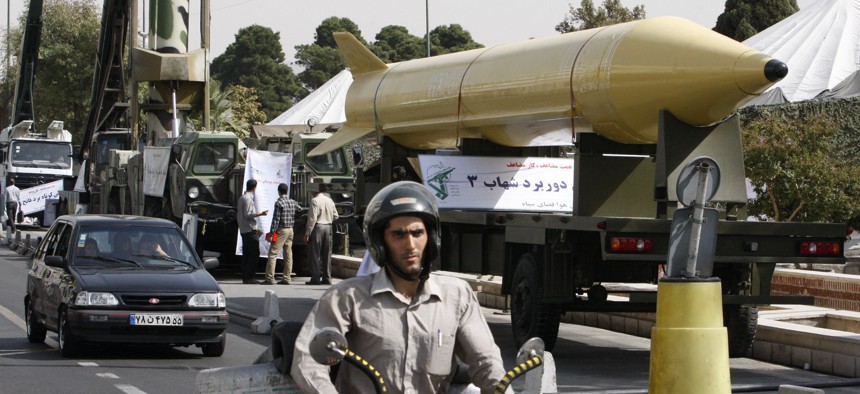
Iranians drive next to a Shahab-3 ballistic missile, which is displayed in an equipment display by the Iranian Revolutionary Guard marking the 30th anniversary of the outset of the1980-88 Iran-Iraq war, at Baharestan Square in Tehran, Iran, in 2010. AP Photo/Vahid Salemi
What We Know About the Missiles Iran Fired Into Iraq
To begin with, they’re getting more accurate.
Iran has improved the accuracy and maneuverability of its missiles, like the ones fired Tuesday at military installations in Iraq housing U.S. and coalition troops, in part with foreign help.
New guidance systems have increased the lethality of Iran's missiles, including the short-range Fateh that appears to have been used in the attacks. But many unknowns remain.
“We don't have a real good, high-fidelity count of the number of missiles that Iran has,” said Michael Elleman, director of the Nonproliferation and Nuclear Policy Programme at the International Institute for Strategic Studies.
Ellerman estimates that Iran has between 200 and 300 Scud missiles and about 100 Shahab-3 medium-range ballistic missiles.
“Once you get beyond 100, it probably doesn't matter because they have a limited number of launchers and launch crews,” he said.
Even less is known about the Fateh. That’s because Tehran makes them indigenously.
“My guess is that the numbers would be measured in the hundreds…if not the high hundreds,” Ellerman said.
Iran has updated the guidance systems on its short-range missiles over the past 15 years.
“The missiles that they test do appear to be having different front ends,” said Tom Karako, who leads the Missile Defense Project at the Center for Strategic and International Studies. “The physical characteristics of a number of these missiles and front-end of these missiles, look a lot like some of the hardware that's been showing up in North Korea.”
Iran also appears to have given its short-range missiles satellite navigation receivers to help them steer on the way down, Ellerman said. The Missile Technology Control Regime, a pact that limits the export of missile technology, bans the transfer of satellite navigation receivers that work on objects flying faster than 1,000 nautical miles per hour and at altitudes above 60,000 feet.
“The use of improved guidance technology and maneuverability during the terminal phase of flight enables these missiles to be used more effectively against smaller targets, including specific military facilities and ships at sea,” the Defense Intelligence Agency said in its most recent assessment of Iran’s military. “These enhancements could reduce the miss-distance of some Iranian missiles to as little as tens of meters, potentially requiring fewer missiles to damage or destroy an intended target and broadening Iran’s options for missile use.”
The satellite navigation receivers on the missiles are likely imported, but from where?.
“I suspect they got some foreign assistance, but I don't know specifically from whom or how,” Ellerman said.
Said Karako, “They're probably getting a lot of help. It's probably from a variety of places.”
Also up for debate is the accuracy of these missiles.
“I don't think they'll achieve that accuracy that they're claiming,” Ellerman said.
Iran also builds an antiship missile, the C-802, under license from China.
“They're quite capable,” Ellerman said. But the U.S., British, and French navies have equipment, technology and training that could defeat them.
More vulnerable are other Gulf nations in Iran’s neighborhood “just because their crews are not nearly as well trained and equipped as the U.S. Navy and the British Navy and French Navy that operate in the region,” Ellerman said. “The anti-ship missiles are a concern. They will place greater demands on the crews in the Gulf and of course, commercial shipping is very vulnerable to such systems.”




